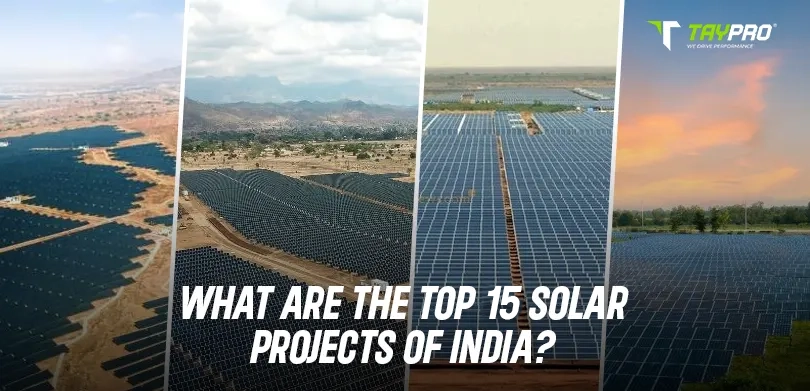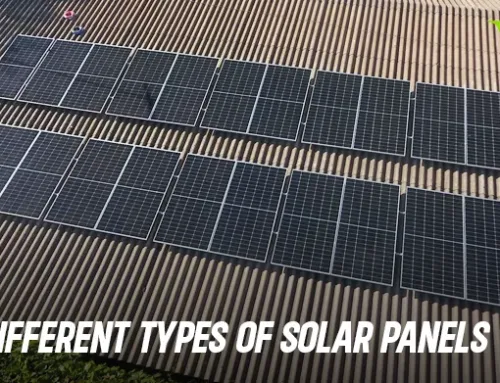India’s becoming a global leader in the solar energy sector with the help of our large solar plants. In this article, we will focus on the largest solar power plants in India and how they are contributing to our solar energy goals.
With India’s ever-growing energy demand, solar energy is leading the charts by being one of the most efficient renewable energy resources.
In the past few years, we have taken remarkable initiatives to adapt solar power, and now it’s visible even in small parts of the country.
With that, let’s have a look at some of the largest solar power plants in India.
Overview of Solar Energy Growth in India
As a country, we have witnessed an exceptional growth in the solar sector, as we are ranked third-largest solar market in the world (after China & US).
The National Solar Mission by the government and the decreasing solar panel rates are the major reasons behind the large solar plants.
Large solar power plants are the sustainable solution for India’s huge energy demands.
Along with generating a huge amount of clean energy, solar plants reduce fossil fuel dependency and lower carbon emissions as well.
Additionally, increased employment opportunities, a thriving local economy and a reliable energy supply are a big boost.
Bhadla Solar Park, Rajasthan
With a capacity of 2245 MW, Bhadla Solar Park in Rajasthan is the biggest solar power plant in India.
It’s also the world’s largest solar power plant, spread over 14,000 acres of land in Jodhpur, Rajasthan.
It’s located in an ideal location, as Bhadla is one of the regions with the highest solar radiation.
As a front-runner in solar energy, this plant has made clean energy affordable by offering some of the lowest power prices.
Its huge size and high efficiency also catch worldwide attention.
Pavagada Solar Park, Karnataka
The 2050 MW capacity of Pavagada Solar Park in Karnataka mkes it one of the biggest solar power plants in India.
Also known as the Shakti Sthala, this plant covers 13000 acres of land in the Tumkur district.
This plant has significantly contributed to transforming a drought-prone region into a major clean energy hub.
The Pavagada Solar Park has made Karnataka one of the top solar-powered states of India.
Along with generating reliable electricity, this plant also creates several employment opportunities for locals, driving both environmental and economic growth in the region.
Kurnool Ultra Mega Solar Park, Andhra Pradesh
As one of the first large-scale solar projects of India, Kurnool solar park has a capacity of 1000 MW.
This power plant, developed across 5,900 acres of land, has laid the foundation for other solar projects in India.
To ensure efficient operations, Kurnool solar park has integrated advanced monitoring systems with smart grid technologies.
This plant played a significant role in making Andhra Pradesh one of the leading solar-powered states of India.
Rewa Ultra Mega Solar Park, Madhya Pradesh
With a capacity of 750 MW, Rewa Solar Park in Madhya Pradesh is one of the largest solar power plants in India, developed by the government and private entities.
This project spans 1,590 hectares and is one of the most renowned solar initiatives in India.
Rewa Solar Park’s affordable solar energy contributes around 60% of Delhi Metro’s daily energy consumption requirements.
This solar project has remarkably reduced solar emissions and is an ideal project for future solar plants.
NP Kunta Solar Park, Andhra Pradesh
NP Kunta Solar Park is another major contributor to Andhra Pradesh’s solar power initiative.
panning across 7925 acres of land, this solar park has a capacity of 978 MW and is considered one of the biggest solar power plants in India.
In addition to generating a clean source of energy, this solar project also creates employment opportunities for residents.
Also, it has provided the regional communities with better infrastructure & lifestyle.
Charanka Solar Park, Gujarat

With a current solar capacity of 500 MW, Charanka Solar Park is one of the first large-scale solar projects in the country.
Located in the Patan district of Gujarat, this project spans over 2000 hectares of land, making it one of the biggest solar power plants in India.
The Charanka Solar Park was the flag bearer for Gujarat’s solar map, inspiring other states to take initiative.
It’s a perfect example of how the ideal policy support can result in quick and effective scaling of solar energy.
Kamuthi Solar Power Project, Tamil Nadu
Located in the Ramanathapuram district of Tamil Nadu, the Kamuthi solar plant has a capacity of 648 MW.
Spanning over 2500 acres of land, this solar plant was the biggest solar location in the world during its inauguration in 2016.
The Kamuthi solar power project has integrated an automatic solar panel cleaning system to maintain the plant’s efficiency.
This plant regularly provides electricity to almost 1.5 lakh homes and is a major contributor to Tamil Nadu’s solar power initiative.
Ananthapuramu Solar Park, Andhra Pradesh
Possessing a capacity of over 1000 MW, Ananthapuramu Solar Park is one of the largest solar plants in India.
Also known as the NP Kunta ultra mega solar park, this project is spread across 11000 acres of land.
This project secures the power supply and reduces the power shortage in Andhra Pradesh.
Over the years, this solar project has been steadily expanding and attracting major investments from different companies all over the world.
Kadapa Ultra Mega Solar Park, Andhra Pradesh
Kapada Ultra Mega Solar Park has a capacity of 1000 MW and plays a significant role in Andhra Pradesh’s solar energy vision.
The project covers a total area of 5927 acres and is implemented by a joint venture called Andhra Pradesh Solar Power Corporation Private Limited (APSPCL).
This solar project was specifically designed with modern infrastructure to handle large-scale solar power generation.
Due to this, the Kapada solar park has made a remarkable contribution to supplying clean energy to the region.
Mandsaur Solar Farm, Madhya Pradesh
As compared to other solar projects, Mandsaur solar farms have a capacity of 130 MW, but they play a key role in meeting local energy demands.
This solar farm has continuously provided reliable, clean energy and reduced the dependency on coal-based power supply.
This farm has also increased employment opportunities in the area.
Chayan Solar Park, Rajasthan
Developed by Tata Power, Chayan Solar Park is a 100 MW solar plant in the Chayan village of the Jodhpur district.
This project spans over 500 acres and is a part of the broader solar initiatives of Tata Power’s Renewable Energy Limited (TPREL)
This project has integrated high-efficiency solar modules and it’s connected to the state’s power grid, providing clean energy to several homes in Rajasthan.
It has also helped in reducing carbon emissions and providing livelihoods to many individuals.
Agar Solar Park, Madhya Pradesh
The Agar Solar Park in the Avada district of Madhya Pradesh has a capacity of 550 MW.
This project is developed on more than 1500 hectares of land, making it one of the biggest solar power plants in India.
The park uses highly efficient technology to generate energy and reduce the usage of coal-based energy production.
Along with creating employment opportunities, this project has significantly supported Madhya Pradesh in achieving its renewable energy goals.
Adani Khavda Solar Park, Gujarat
This under-development solar park in Khavda, Gujarat, will have the potential to produce a total of 30000 MW of energy, which will make it the world’s largest solar power plant.
Developed by the Adani group, this project will cover 72,600 hectares of land and it’s currently operating on 1000 MW.
The location of this project has high solar radiation, which is very suitable for energy production.
The project is still in its early phases and is still contributing power to the grid. Post completion, it will be the biggest renewable energy source in the world, reducing carbon emissions by a huge amount.
Nokh Solar Park. Rajasthan
The Nokh Solar Park is one of the biggest solar power plants in India with a capacity of 925 MW.
The project is spanning across 2000 hectares of land in the Jaisalmer district of Rajasthan.
It uses advanced technology for high efficiency, and it’s projected to reduce over 2 million tonnes of carbon emissions.
Radhanesda Solar Park, Gujarat
This project is an under-development ultra mega solar park, with a potential capacity of over 700 MW.
Developed over 1400 hectares of land, Radhanesda Park is one of the biggest solar power plants in India.
Over the next few years, the project is estimated to reduce carbon emissions by 2,00,000 tonnes annually per 100 MW.
This project is a cornerstone for Gujarat’s solar power goals.
Key Points to Remember
States like Rajasthan, Karnataka and Andhra Pradesh are leading the charts with large-scale solar projects in India.
Their geographical location, supportive policies, and forward-looking approach have played a huge role in making it possible.
At present, solar energy accounts for 57% of India’s total renewable energy consumption.
Large solar parks are helping our country reach near the goal of achieving 500 GW of non-fossil fuel-based capacity by 2030.
Conclusion
These large solar power plants in India not only generate a huge amount of electricity, but also reflect our commitment towards clean & green energy.
With decreasing costs and increasing innovations, we can expect a brighter future with more affordable and efficient solar power plants in India.
FAQS
With a capacity of 2245 MW, Bhadla Solar Park, Rajasthan, is the biggest solar power plant in India. |
The Pavagada solar park is located in the Tumkur district, Karnataka. |
The Kurnool Solar Park produces 1000 MW of clean energy. |
The Rewa Ultra Mega Solar Park in Madhya Pradesh has a capacity of 750 MW. |
The Charanka Solar Park in Gujarat is one of India’s first large-scale solar projects. |
Andhra Pradesh has the largest number of large-scale solar projects, such as the Kurnool, Kadapa, and Ananthapuramu solar parks. |





